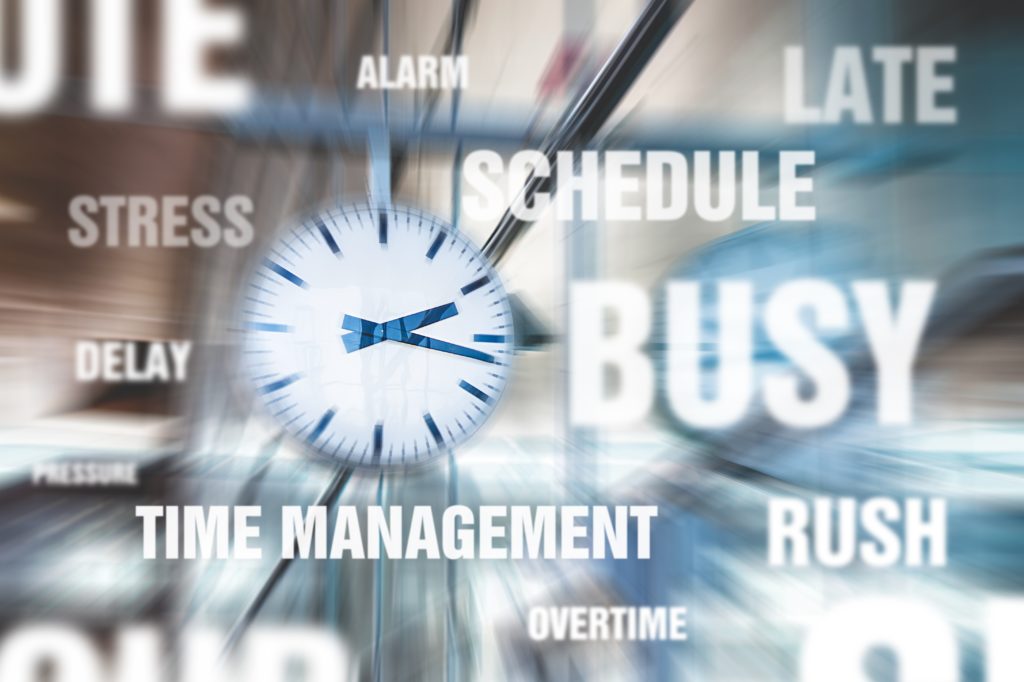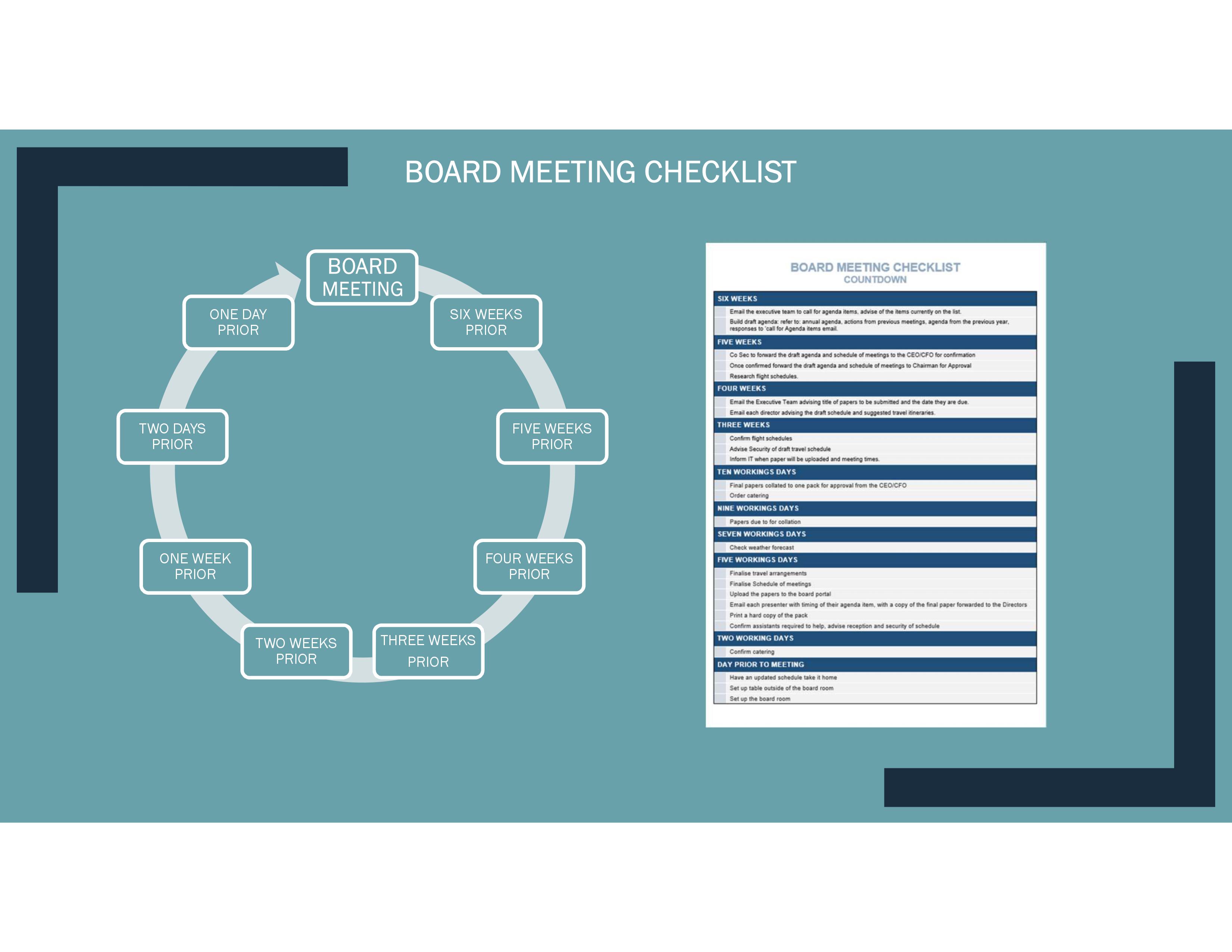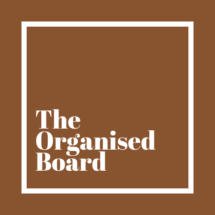Board Meeting Checklist

Having a board meeting checklist will reduce being overwhelmed when arranging meetings.
Planning as far ahead as possible is key. Having routine tasks such as catering orders and travel schedules drafted in advance will free up time when plans change at the last minute.
A comprehensive board meeting checklist also allows for others to be aware of what is required by when.
One of the most important parts of the board meeting checklist is scheduling time following the meeting with the Company Secretary to review what went well, what you would do differently and make notes for next meeting.
Equally as important is to acknowledge key staff and suppliers who helped the meeting become a success.
Below is a snapshot of what needs to be done by when. Download the full comprehensive board meeting checklist here.

SIX WEEKS PRIOR TO THE MEETING
- Start building the board meeting agenda;
- Review notes from the post meeting debrief from the previous meeting and the meeting held at the same time last year;
- Book restaurant for the board dinner;
- Research flights for directors who will be travelling.
FIVE WEEKS PRIOR TO THE MEETING
- Call for agenda items – email the Executive team advising the known items on the agenda.
FOUR WEEKS PRIOR TO THE MEETING
- Collate the responses to the Call for Agenda items email;
- Populate the Board meeting agenda;
- Draft the Schedule of Meetings;
- Company Secretary will email the draft board agenda to the CEO for approval; and
- Once approved by the CEO the Company Secretary will forward to the Chairman for approval.
THREE WEEKS PRIOR TO THE MEETING
Once the Chairman has approved the agenda:
- Email each director advising the Schedule of Meetings and suggested flights;
- Confirm restaurant reservations;
- Confirm the CEO’s calendar is clear for them to review papers and return to Co Sec at the agreed dates.
- Order stationery, if required;
- Advise internal teams of the board meeting times i.e. Reception, Building Management, Security etc;
- Email IT department requesting no major maintenance is scheduled on the days papers are due to Company Secretariat and on the day of the meetings; and
- Email the teams who have items on the agenda advising of the dates the papers are due to Company Secretariat for collation. Include a copy of the Board meeting paper template and Board paper template formatting guidelines.
10 WORKING DAYS PRIOR TO THE MEETING
- Finalise all travel arrangements;
- Test IT Equipment;
- Order catering for meetings;
- Ask an EA to be available to support you on the day of the meeting;
- Request a senior IT team member be available when the board is in session.
7 WORKING DAYS PRIOR TO THE MEETING
Papers Due to Company Secretariat.
- Print draft agenda and add to the clipboard;
- As papers are received cross them off the draft agenda;
- Collate papers for CEO approval; and
- Provide the board pack for CEO review and approval.
6 WORKING DAYS PRIOR TO THE MEETING
- Finalise travel arrangements;
- Prepare car transfers schedule; and
- Confirm Catering, external bookings.
5 WORKING DAYS PRIOR TO THE MEETING
Once the pack has been approved for distribution by the CEO:
- Collate the papers and issue to the directors; and
- Email proponents/presenters with a copy of the paper issued to the directors and the time they have been allocated on the agenda.
Note: As details change constantly it is important to know what information the directors have in front of them so changes can be addressed, if required. Timing is everything. Note the allocated time the proponent/presenter is required to attend the meeting, advise them to allow 20 minutes of lea way either side in case the meeting is either behind or ahead of schedule.
As a guide it is always advisable for the Executive team to avoid external meetings or meetings where they may need to leave at the last minute.
2 WORKING DAYS PRIOR TO THE MEETING
- Finalise travel arrangements including, car transfers and email to the directors; and
- Draft the Skeleton Minutes.
ONE DAY PRIOR TO THE MEETING
- Email the Executive Assistants and advise of meeting time changes;
- Set up the boardroom with power cords, notepads,pens etc;
- Layout name cards if, required.
- Test IT equipment;
- Print the schedule of meetings and car transfers and display them in the Boardroom;
- Print the agenda, meeting agenda, annual schedule calendar for the current year and following year;
- Run through the schedule of meetings with the Executive Assistants who will be assisting you;
- Confirm IT have a support person on stand by and advise the times the board will be in session;
- Confirm any meeting the directors may have with management;
- Advise reception when the directors will be arriving departing; and
- Allow for last minute changes.
DAY OF THE MEETING/S
- Arrive at lease one hour prior to the commencement of the meeting;
- Ensure catering is in place;
- Advise presenters if the meeting is running ahead or behind schedule;
- Be prepared for ad-hoc requests i.e. director breaks a shoelace, has an ear infection, a headache, needs to buy a gift, send flowers etc;
- Keep the Company Secretary informed if any thing that may be relevant;
- Note if a director leaves a meeting and when they return;
- Note when a presenter enters and leaves the room; and
- Note when the meeting starts, break times and meeting end time.
FOLLOWING THE MEETING
- note the time the meeting ended;
- clear the boardroom;
- return or shred left over printed material;
- seek feedback from presenters, suppliers and EA’s;
- meet with Company Secretary for post meeting briefing;
- update the meeting checklist with notes from the post meeting briefing;
- process expenses claims; and
- Plan some downtime, it’s all about to start again!
Want to be a Board Coordinator? Read this first!

